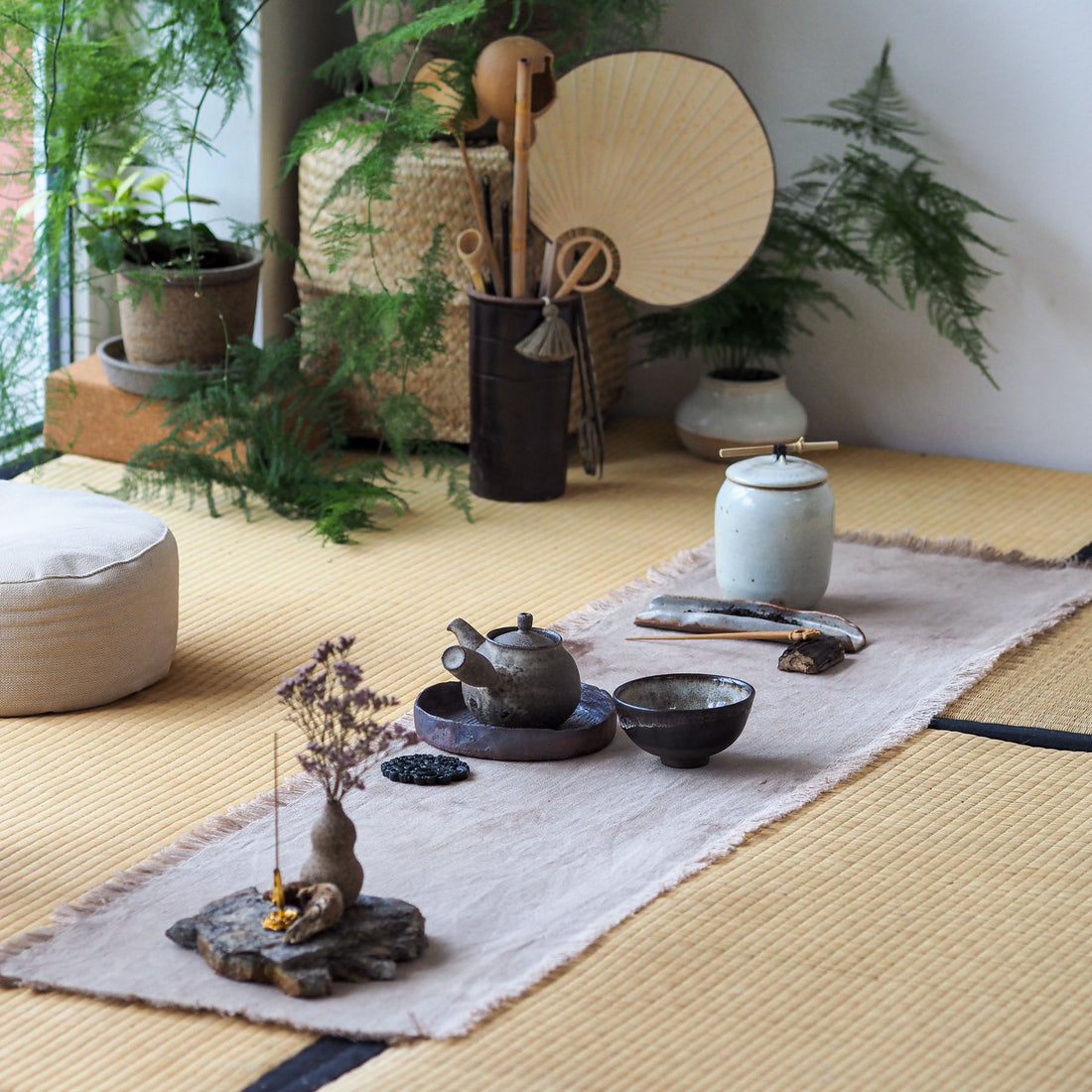
The Foundations of Chaxi
When we pay attention, whatever we are doing... is transformed and becomes a part of our spiritual path. We begin to notice details and textures that we never noticed before. Everyday life be- comes clearer, sharper and at the same time more spacious. —Rick Fields
Philosophy
There are three foundations for creating a tea space: the practical, the aesthetic and the spiritual. They grow one from the other and are not mutually exclusive, as it may seem at first glance, but rather complement one other. Every single tea person on this planet creates some kind of chaxi on the practical level, knowingly or unknowingly, you just can’t avoid it. When you choose teapot and cup and bring it to a tea spot — well, congratulations, you just made a simple chaxi. As with everything in the world of tea, this can be done mindfully with knowledge and awareness or be simply ignored and done as a matter of routine. When you think about it deeply, everyone follows some philosophy or other, and the one that has had no intention, thought or will applied to it is perhaps the worst philosophy of all. Maybe the same is true of chaxi. Once, I saw twenty books in a bookstore that were all about how to sleep properly. I couldn’t help but laugh. Why would we need books about something every- one knows how to do and does every day quite successfully? Out of curiosity, I read one of these books a couple of years ago and it changed not only how I sleep, but also when and what I eat, how I exercise and even how I travel. In fact, it has greatly affected my life. Something I thought couldn’t be improved with attention, care and learning was actually a doorway to a whole world of wonder that improved my life—because, you know... it’s all interconnected.

The practical approach to a creating a tea stage is functional. You need tools to brew tea, so you get out all you need and arrange it on your stage in the most practical way, so that everything is at hand, convenient and functional. You must know how it will be used to allow ample space for it. The perfect chaxi on a functional level is when you have everything in the right place before you start, so that during the tea ceremony you don’t have to leave the table or ask someone to hand you the jian shui or fetch a tea towel; you have everything you need to fully immerse yourself in the process of preparing tea and serving the guests.
When guests come to sit in a room to share tea together, they are offering us something extremely precious, something that isn’t recoverable once given: their time and attention. Our task is to use that time and attention as well as possible, and make the experience rewarding for them. So, if you’re going to gift people with a wondrous time together, you first have to spend some time preparing. Rambling is not an option. Interrupt the ceremony because “oh, I forgot something” is also not an option. When we make tea for others, we need a list of everything we need ahead of time. We can then run through each step in our mind’s eye from start to finish and make sure we have everything we need before we start. All this preparation pays off a hundredfold in the tea. The energy we invest in preparation changes the ceremony itself, in other words.

Aesthetics
There is one thing in the world where there is no culture gap: beauty. Whether you are American, Russian or Chinese, we all understand and feel beauty. It is a deep and human part of our aesthetics and emotions. Being human, we are receptive to beauty, and it touches the very depths of our being, allowing us to respond and open up. I think whatever we do — be it music, tea or design — this is a key element. Preparation for a celebration looks the same everywhere on this planet: we clean and decorate the space. At every level of the human experience, we are looking for the beautiful, something that gives meaning to our souls, not just our physical needs. We head outdoors to share tea in Nature because we yearn to commune with the beautiful. We crave the sublime, and that’s why the starting point for all things tea is the beautiful, not just the practical. Beautiful moments are available to us whenever we want them. All we have to do is open our eyes. A petal that has fallen on the table, curls of steam over a cup of tea, a ray of sunshine gliding across the room, the sound of the water starting to boil in the kettle, the deafening songs of birds outside—the more clearly we are able to perceive the existing beauty, the more we are able to enhance the beauty of the moment in the tea room. Don’t let the beauty of life escape you. See the world as the temple that it is. And your tea place is an altar of beauty over which you have full reign. The more you notice beauty in your home, your life and in the world, the better you will be at decorating, at inviting this beauty into your tea space.

Spirituality
Setting up a tea space is like building a mandala. The word “mandala,” originally a Sanskrit word, simply means a “circle,” and, by extension, a “world.” In the Buddhist traditions, mandalas are also symbolic circles that represent the entire world in a microcosm. A mandala is often created from fine multi-colored sand, placed grain by grain in an intricate circle. Creating a sand mandala can take weeks and requires intense concentration, but the ritual practice requires the mandala be destroyed or dismantled after its completion. The impermanence of all created things is enacted here in the painstaking creation of an intricate, exquisite work of art, and its destruction. A symbolic world comes into being, grain by grain, and then passes away— swept up and returned to the formless from whence it came.
The most incredible thing is that all parts of the process—from the very first steps of creating a drawing, to the final ritual destruction—are equally important and beautiful. Not just the moment when the mandala is ready and flawless, but every moment that leads to it is equally poignant. Eventually, the smooth and perfect lines are ritually swept away and become a multi-colored mess, which is also beautiful in its own way. A mandala is a practice that combines the best of meditation, offerings and purification in one very powerful act. Do you notice how much this is like a tea practice in essence? A symbolic world comes into being, bowl by bowl, and then naturally passes away.

You bring elements into an empty space, creating a harmonious, flawless stage on which the tea blossoms. You allow tea to fill all the innermost folds of your heart, saturate the mind and soul, fill the body with joy and peace. Everything arises, happens and then disappears. Naturally and beautifully, the tea session comes to an end. Ev- eryone who participated will have a beautiful imprint in his or her heart, the same as people observing the cre- ation of a mandala. And for the brew- er, approaching a tea ceremony as a part of his or her spiritual practice of- fers the most transparent mirror one could ever wish for. Our state of mind influences the way we move, act and talk—everything we do, everything we create. When serving tea to others, we can clearly see our state of mind, mental habits and tendencies. But the best thing is that with every sip of tea we become more peaceful and clos- er to harmony. Therefore, even if for some reason we start the session feel- ing somewhat excited, we will end in a place of calm and balance.

To finish this article, I would like to share three of the most useful tips that I have spied from tea masters I’ve been lucky to observe:
One of the best tips I’ve learned about creating a tea stage is to add elements slowly, listening to the space, intention and objects interact with each other. When we bring all the elements in gradually, one by one (not all at once), the chaxi grows, instead of tumbling together, and ultimately turns out a little differently than it would otherwise. This means doing everything at the right speed. Instead of striving to do things faster, slower movements allow us to focus on do- ing things better. Often, that means slowing down and spending the right amount of time on the things that matter most to you. How should I express my intention? How can I use the elements I have? What color or texture will highlight my idea? More often than not, slowing down reminds us that less is indeed more. Such min- imalism can sometimes be surprising. In reality, negative space is precisely what generates the beauty. This emptiness, which isn’t really empty, is beautiful in its own right. And when you do things slowly, you can feel it. Hopefully, your guests will feel it as well.

The second tip is that if you are lucky to have guests and share tea with others, then after you set up chaxi, go around the table and look at the result from the guests’ perspective. You will be surprised! Perhaps some elements will need to be moved or changed. Quite often, looking from the other side of the table helps to create a more balanced and harmonious tea stage. We get stuck in the host’s perspective, even though we are trying so hard to honor the guests.

The third tip is a quick test of whether you have managed to create a harmonious chaxi or not. As in the second tip, you walk around the table, sit in a guest’s seat and close your eyes for a couple of seconds. Breathe... Then slowly open your eyes. What is the very first thing that catches your eye? This is the center of attraction of your chaxi. What should be at the center of attraction of any tea stage? The tea— perhaps leaves in a bowl or the teapot. The center should not be a flower vase, a scroll or a gorgeous sculpture. If your chaxi is created in such a way that the eyes are drawn to the tea, well done, you did it! Tea is always the star of our show. If we lose the tea in favor of the chaxi, or any of its elements, we have swapped the background and foreground and our chaxi has become overdone. This is an easy mistake to make in the beginning ofourpractice.Thistipcanreallyhelp us to catch the times when we add too many or overly distracting elements and then we can take them out so the tea can better shine front and center.

When you return to the host’s seat, remember that the center is also not you, sitting there in the center and serving tea. The center of gravity should be Tea Herself and all else orbits Her. Make sure your movements never draw attention to yourself, pulling your guests’ attention away from their tea, for the experience is their own. Tea has her own messages to share.
- This article was originally published in the July 2022 issue of Global Tea Hut magazine. It’s an honor to share my thoughts through a magazine rich with tea history, lore, processing techniques, and the spiritual aspects of Cha Dao. Being a part of a magazine that deeply respects and celebrates the heritage of tea is truly special, and I’m grateful for the opportunity to contribute to such a vibrant community.
